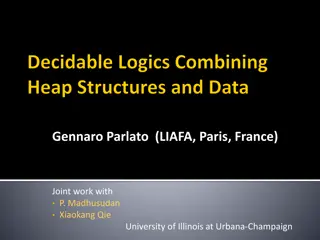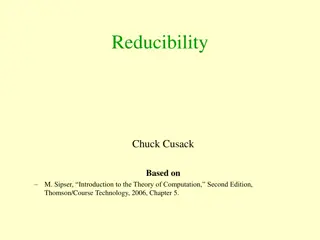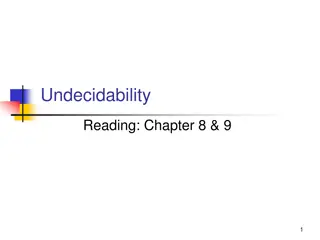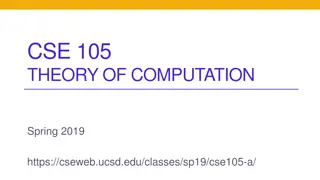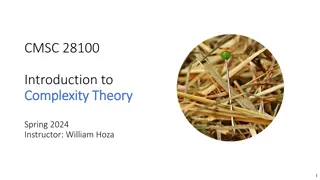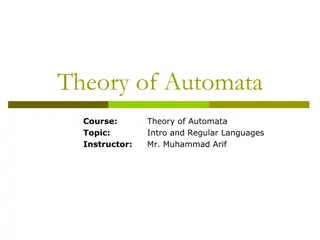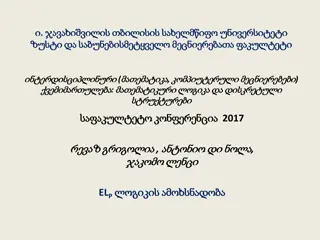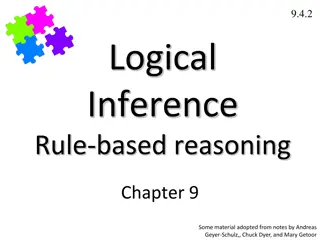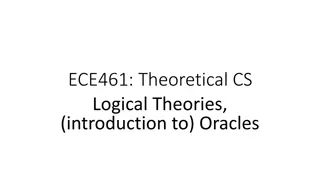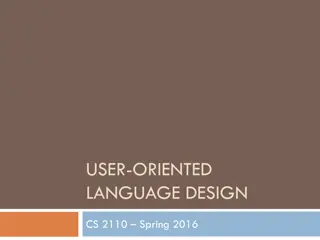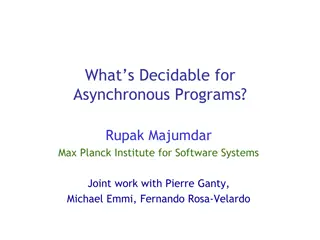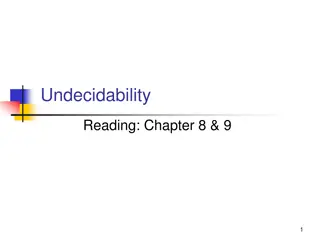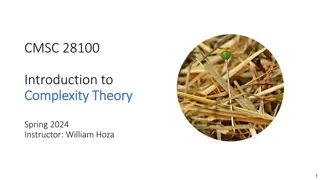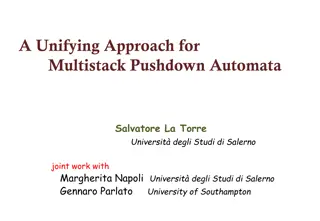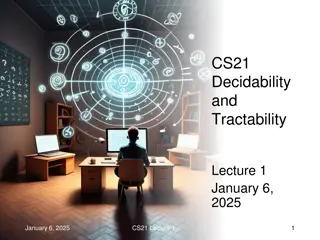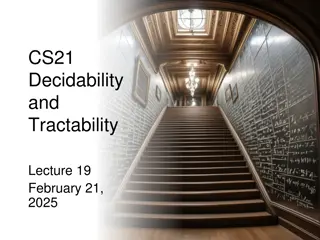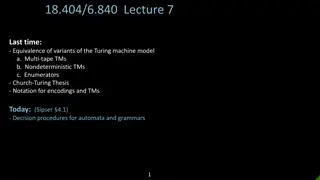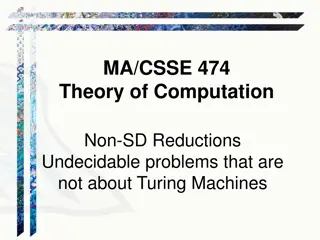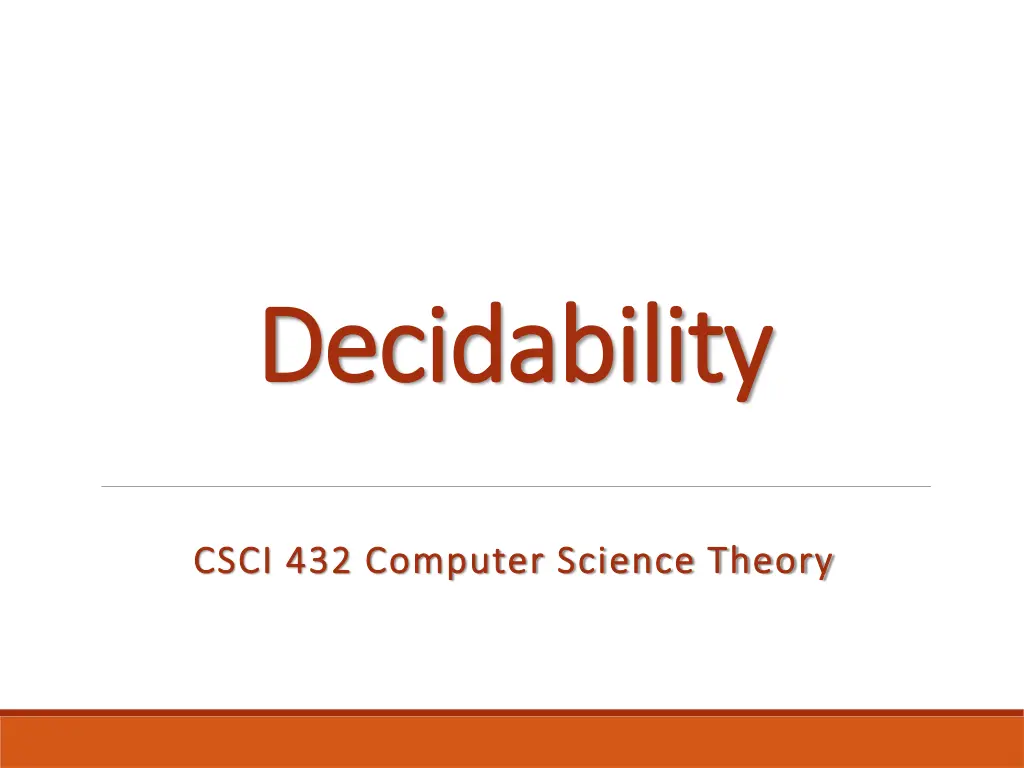
Understanding The Importance of Decidability and Turing Machines in Computer Science Theory
Explore the fundamental concepts of decidability, Turing Machines, and their significance in Computer Science Theory. Learn how Turing Machines can implement any algorithm and the distinction between decidable, Turing recognizable, and not Turing recognizable languages.
Download Presentation

Please find below an Image/Link to download the presentation.
The content on the website is provided AS IS for your information and personal use only. It may not be sold, licensed, or shared on other websites without obtaining consent from the author. If you encounter any issues during the download, it is possible that the publisher has removed the file from their server.
You are allowed to download the files provided on this website for personal or commercial use, subject to the condition that they are used lawfully. All files are the property of their respective owners.
The content on the website is provided AS IS for your information and personal use only. It may not be sold, licensed, or shared on other websites without obtaining consent from the author.
E N D
Presentation Transcript
Decidability Decidability CSCI 432 Computer Science Theory CSCI 432 Computer Science Theory
Recap of last two weeks Recap of last two weeks Turing Machines are powerful enough to implement any algorithm. TMs can implement any machine level functions of a modern computer. Because high-level languages can be translated into assembly code, any program written in a high-level language can be run on a TM. Any algorithm that can be carried out by a Human can also be run by a TM (Church-Turing)
Thus Thus 1. We do not have to draw out a TM to show the problem can be solved. It is sufficient that we can describe the algorithm. 2. Also, there are some problems that are not solvable. o There exist no TM that solves the problem. "Algorithm" - can be rendered as a TM that halts on all inputs.
Not Decidable Set of All Languages Turing Recognizable Decidable Languages Context Free Languages regular languages
Languages Languages Decidable Language There exist a TM that, when given any input string w, will 1. always halt 2. accept w that is in L 3. reject w that is not in L "Decidable" = "Recursive", "Computable" and "Solvable"
Languages Languages Turing Recognizable Language There exist a TM that, given any input string w, 1. when w is in L, the TM will accept and halt 2. when w is not in L, the TM will either a) reject and halt, or b) loop infinitely "Recognizable" = "Recursively Enumerable", "Partially Decidable", or "Semi-Decidable"
Languages Languages Not Turing Recognizable Language For the best TM for that language: 1. when w is in L, a TM will either a) accept and halt, or b) loop infinitely 2. when w is not in L, a TM will either a) reject and halt, or b) loop infinitely "Not Recognizable" = "Not R.E." or "Not Partially Decidable" or "Undecidable Language"
Purpose of TMs Purpose of TMs 1) "decides" a language if the language is decidable 2) "recognizes" a language if the language is Turing Recognizable 3) "computes" functions "totally computable function" defined for all inputs and halts "partially computable function" undefined on some inputs
Universal Turing Machines Universal Turing Machines Since a TM can compute anything that is computable, there are Turing Machines that can preform computations on other Turing Machines. A Universal Turing Machine executes operations on another Turing Machine. the UTM is like hardware the TM that is being operated on is like software
Universal Turing Machines Universal Turing Machines To input a TM (M) into a UTM (U), M's tape, states, and transitions must be encoded. that encoding format is similar to the method we used to represent transitions in PDAs Implementation of U is usually done as a 3-tape TM. tape 1 - M's tape tape 2 - M's transitions tape 3 - current state of M
The Halting Problem The Halting Problem Given a TM, will it halt when run on some particular input? There is no generalized algorithm that can tell us ahead of time whether or not an algorithm will halt. The best we can do is run the program and observe whether it halts or loops infinitely. So For programs in general, halting is undecidable.
Halting Problem Halting Problem Given a TM (M) and input (w), we do not know if {M,w} is decidable. o Will {M,w} halt if w is accepted or if w is rejected? o We don't know until we run it. Proof: Assume {M,w} is decidable. Create a function H that accepts M and w and outputs either "halts" or "does not halt". o H is a "decider" and thus must always halt. o Spoiler Alert: H cannot exist.
Proof continued: Create another TM (D) that calls H as a subroutine. But, o if H outputs "halts" have D loop forever o if H outputs "does not halt" have D halt. Now, call D with D as its input. So D must decide (by halting) if D halts or does not halt. So, if D determines D(D) halts, D runs forever because it is looping forever it never stops to give us an answer if D determines D(D) does not halt, then it halts but it can't halt because we forced it to loop forever.
Halting Problem Halting Problem Conclusion: There cannot exist a function (H) that can examine a TM (M) and input (w) and determine by examination that M halts on w. H(M,w) does not exist. Thus, we must run M on w to determine if it halts.
Vocabulary Note Vocabulary Note The "Turing Test" has nothing to do with Turing Machines The "Turing Test" is an AI problem. Can we create a machine that is impossible to distinguish from a human?
Next Class Next Class P vs. NP Does there exist an efficient algorithm to solve my problem? if your problem is sorting, then yes if your problem is routing delivery trucks, then we don't know


